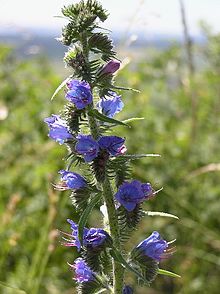Echium
| Echium | |
|---|---|

| |
| Echium vulgare | |
| Scientific classification | |
| Kingdom: | Plantae |
| Clade: | Tracheophytes |
| Clade: | Angiosperms |
| Clade: | Eudicots |
| Clade: | Asterids |
| Order: | Boraginales |
| Family: | Boraginaceae |
| Subfamily: | Boraginoideae |
| Genus: | Echium L. |
| Species | |
|
See text. | |





Echium /ˈɛkiəm/[1] is a genus of 60 species of flowering plant in the family Boraginaceae.
The type species is Echium vulgare (viper's bugloss). Species of Echium are native to North Africa, mainland Europe and the Macaronesian islands where it reaches its maximum diversity.[2]
Taxonomy
The Latin genus name comes from the Greek word 'ekhis' which means viper (a type of snake). Some sources say that this is due to the seeds resembling a viper' head. Others claim that the forking at the end of the thin flower style resembles a viper's tongue. It is also claimed that the plant roots when eaten with wine could provide a folk cure for a snake bite.[3]
Uses
Many species are used as ornamental and garden plants and may be found in suitable climates throughout the world. In Crete Echium italicum is called pateroi (πάτεροι) or voidoglosses (βοϊδόγλωσσες) and its tender shoots are eaten boiled or steamed.[4]
Echium species are used as food plants by the larvae of some Lepidoptera species including Coleophora onosmella and orange swift.
The seed oil from Echium plantagineum contains high levels of alpha linolenic acid (ALA), gamma linolenic acid (GLA) and stearidonic acid (SDA), making it valuable in cosmetic and skin care applications, with further potential as a functional food, as an alternative to fish oils.[5]
Invasiveness
Some species have become invasive in southern Africa, California and Australia. For example, Echium plantagineum (Patterson's Curse), has become a major invasive species in Australia.
Species
- Echium aculeatum Poir.
- Echium albicans Lag. & Rodr.
- Echium amoenum Fisch. & Mey.: Gol-e-Gavzaban or Gol Gavzaban
- Echium anchusoides Bacch., Brullo & Selvi
- Echium angustifolium Lam.
- Echium arenarium Guss.
- Echium asperrimum Lam.
- Echium auberianum Webb et Berth. Slopes of the Teide Volcano on Tenerife Island in the Canary Islands
- Echium bethencourtii Santos.
- Echium biebersteinii Lacaita.
- Echium boissieri Steudel.
- Echium bonnetii Coincy.
- Echium brevirame Sprague et Hutch.
- Echium callithyrsum Webb ex Bolle.
- Echium candicans L. fil. : pride of Madeira.
- Echium creticum L.
- Echium decaisnei Webb.
- Echium flavum Desf.
- Echium gaditanum Boiss.
- Echium gentianoides Webb ex Coincy (synonym of E. thyrsiflorum Masson ex Link)
- Echium giganteum L. fil.
- Echium glomeratum Poir.
- Echium handiense Svent.
- Echium hierrense Webb ex Bolle
- Echium horridum Batt.
- Echium humile Desf.
- Echium hypertropicum Webb.
- Echium italicum L. : pale viper's-bugloss
- Echium judaeum Lacaita.
- Echium khuzistanicum Mozaff.
- Echium lancerottense Lems et Holz.
- Echium × lemsii G.Kunkel.
- Echium leucophaeum Webb ex Sprague et Hutch.
- Echium longifolium Delile.
- Echium lusitanicum L.
- Echium modestum Ball.
- Echium nervosum Dryand. in W.T. Aiton
- Echium onosmifolium Webb & Berthel.
- Echium orientale L.
- Echium pabotii Mouterde.
- Echium parviflorum Moench : small-flowered viper's-bugloss
- Echium petiolatum Barratte & Coincy.
- Echium pininana Webb et Berth. : giant viper's-bugloss
- Echium pitardii A.Chev.
- Echium plantagineum L. : purple viper's-bugloss, Patterson's curse, Salvation Jane
- Echium rauwolfii Delile.
- Echium rosulatum Lange : lax viper's-bugloss
- Echium rubrum Forssk.
- Echium russicum J.F.Gmel.
- Echium sabulicola Pomel.
- Echium salmanticum Lag.
- Echium simplex DC.
- Echium spurium Lojac.
- Echium stenosiphon Webb.
- Echium strictum L.f.
- Echium suffruticosum Barratte.
- Echium sventenii Bramw.
- Echium x taibiquense P.Wolff & Rosinski.
- Echium tenue Roth.
- Echium thyrsiflorum Masson ex Link.
- Echium triste Svent.
- Echium tuberculatum Hoffmanns. & Link.
- Echium velutinum Coincy.
- Echium virescens DC.
- Echium vulcanorum A.Chev.
- Echium vulgare L : viper's bugloss
- Echium webbii Coincy.
- Echium wildpretii Pears. ex Hook. fil.
- Echium wildpretii subsp. trichosiphon
References
- ^ Sunset Western Garden Book, 1995:606–607
- ^ Böhle, U.-R., Hilger, H.H. & Martin, W.F. 2001. Island colonization and evolution of the insular woody habit in Echium L. (Boraginaceae). Proceedings of the National Academy of Sciences 93:11740-11745.
- ^ W. T. Parsons, William Thomas Parsons and E. G. Cuthbertson Noxious Weeds of Australia, p. 325, at Google Books
- ^ Kleonikos G. Stavridakis , Κλεόνικος Γ. Σταυριδάκης (2006). Wild edible plants of Crete - Η Άγρια βρώσιμη χλωρίδα της Κρήτης. Rethymnon Crete. ISBN 960-631-179-1.
- ^ National Non-Food Crops Centre. NNFCC Crop Factsheet: Echium
